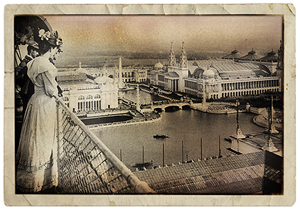| Sun | Mon | Tue | Wed | Thu | Fri | Sat |
|---|---|---|---|---|---|---|
| 1 | 2 | 3 | 4 | 5 | ||
| 6 | 7 | 8 | 9 | 10 | 11 | 12 |
| 13 | 14 | 15 | 16 | 17 | 18 | 19 |
| 20 | 21 | 22 | 23 | 24 | 25 | 26 |
| 27 | 28 | 29 | 30 | 31 |
CATEGORIES
RECENT ENTRIES
BLOG ROLL
A morning at the fair
 We’re standing at the steps of the Museum of Science and Industry, and Paul Durica, AM’06, is organizing his players like a nervous elementary-school choir director.
We’re standing at the steps of the Museum of Science and Industry, and Paul Durica, AM’06, is organizing his players like a nervous elementary-school choir director.
Grover Cleveland, you’re at the top. George Pullman, you’re next to Thomas and Bertha Palmer. And where are the Duke and Duchess of Veragua?
It’s the opening scene of Durica’s Working Man’s Guide to the World’s Columbian Exposition, a two-hour walking tour of the 1893 World’s Fair, part of Durica’s Pocket Guide to Hell Tours.
At first, I wasn’t quite sure what to look for. When Durica arrives, his blue marching-band jacket, complete with gold braid patterns and red tassels, announces him as our guide. Dressed as a Columbian Guard—a member of the fair’s security force—he assigns character roles to several tour-goers.
He instructs one woman to play a disgruntled Ida B. Wells and provides her with a sample of the antiracism pamphlets that Wells handed out in 1893. Later Durica notifies “Jane Addams” that her purse had been stolen, but—don’t worry—a Columbian Guard had retrieved it. I play Clarence Darrow for the post-fair segment, and Durica informs me that my ashes had been spread in the lagoons behind the museum.
Durica, a PhD student in English, makes the morning a pleasant stroll through the former fairground. He offers a detailed description of every aspect of the fair, from the 40,000 workers who labored for two years preparing the White City to the 264-foot Ferris Wheel to the economic turmoil of the 1890s that led to the mini-city’s quick demise when the fair ended.
The tour begins at the eastern steps of the museum and progresses through seven stops around the lagoons to the south. With a wealth of knowledge from his research at the Regenstein Library, Durica emphasizes the fair’s behind-the-scenes production, such as the construction of the massive Manufactures and Liberal Arts building and the failed plans for a revolutionary theater called the Spectatorium.
Durica has two more tours planned for August and September, one looking at jazz and blues on the South Side and the other uncovering the “secret history” of the University of Chicago. The tours are free, though the tips Durica accepts are well-earned.
Jake Grubman, ’11
RELATED LINKS
- Pocket Guide to Hell Tours (Facebook)
July 24, 2009
